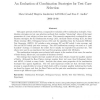Free Online Productivity Tools
i2Speak
i2Symbol
i2OCR
iTex2Img
iWeb2Print
iWeb2Shot
i2Type
iPdf2Split
iPdf2Merge
i2Bopomofo
i2Arabic
i2Style
i2Image
i2PDF
iLatex2Rtf
Sci2ools
ESE
2006
2006
An evaluation of combination strategies for test case selection
This paper presents results from a comparative evaluation of five combination strategies. Combination strategies are test case selection methods that combine "interesting" values of the input parameters of a test subject to form test cases. This research comparatively evaluated five combination strategies; the All Combination strategy (AC), the Each Choice strategy (EC), the Base Choice strategy (BC), Orthogonal Arrays (OA) and the algorithm from the Automatic Efficient Test Generator (AETG). AC satisfies n-wise coverage, EC and BC satisfy 1-wise coverage, and OA and AETG satisfy pair-wise coverage. The All Combinations strategy was used as a "gold standard" strategy; it subsumes the others but is usually too expensive for practical use. The others were used in an experiment that used five programs seeded with 128 faults. The combination strategies were evaluated with respect to the number of test cases, the number of faults found, failure size, and number of decis...
| Added | 12 Dec 2010 |
| Updated | 12 Dec 2010 |
| Type | Journal |
| Year | 2006 |
| Where | ESE |
| Authors | Mats Grindal, Birgitta Lindström, Jeff Offutt, Sten F. Andler |
Comments (0)

